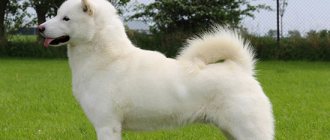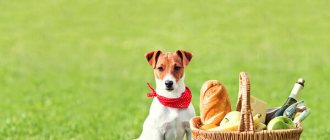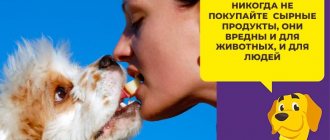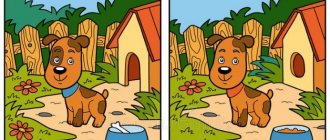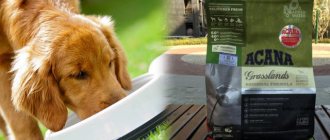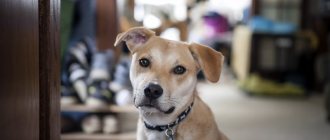Owners often spay their animals to avoid hormonal surges that change their pet's behavior and personality. If the dog is not intended for breeding and will simply be a favorite in the family, then castration is the best way to preserve the health of the pet and the breeder’s nervous system. The operation does not affect the condition of the body in any way, the dog becomes more obedient, balanced and better in contact with the owner. In this article we will look at how to choose food for sterilized dogs, how they differ, composition and rating of the best manufacturers.
What is sterilization
Sterilization or castration is an operation to disrupt the functioning of the reproductive organs. The procedure is common both among mongrel dogs and among dogs of noble breeds in order to avoid unwanted pregnancy in females and procreation in males.
Natural instincts to find a partner are reduced to nothing, which allows you to calmly walk with your pet on walks and play with other dogs without consequences.
Veterinarians recommend sterilization for puppies at 6-8 months. Puppies recover faster, tolerate the postoperative period easier, and have fewer complications.
After the operation, the dog cannot be fed for the first 24 hours; only water is needed in small quantities. On the second day, start giving dry food, dividing the usual daily portion into 3-4 parts. In 5-7 days the pet will fully recover.
What is the difference between food for sterilized dogs and regular dog food?
During surgery, the dog's hormonal levels decrease, the pet becomes less active and lazy, which can affect its health. Males are more sensitive to sterilization. In castrated animals, appetite increases and natural activity decreases. Bitches tolerate surgery more easily, and their eating behavior remains virtually unchanged.
The owner’s main task after surgery is to help the dog recover. You need a calm environment in the home and proper nutrition, which includes vitamins, minerals and a minimum amount of fatty components in the diet. If your dog's diet consists of home-cooked food, it will be difficult to achieve the necessary balance of components.
After surgery, veterinarians recommend changing the diet and switching the pet to commercially balanced food to avoid obesity and related diseases.
Food for dogs that have undergone sterilization or castration is characterized by a decrease in protein in the food. The basis is lean meat, chicken and sea fish.
The composition contains more vegetables, cereals and a special additive L-Carnitine, which increases metabolism and burns excess fat in the body. The lipid content decreases by 12-14% and the protein volume increases by 10-12% - this gives quick saturation.
Caring for a dog after sterilization on the first day
The first day after sterilization is especially important for the animal. When recovering from anesthesia, the dog may behave inappropriately, may pee under itself, or fall out of a chair or bed. For this reason, it should not be placed in elevated places. The bed must be covered with a sterile disposable diaper (sold in pharmacies) and changed regularly when it gets wet.
Sterilization operation
Important! If urinary incontinence occurs for a long time after the release of anesthesia, consultation with a veterinarian is necessary.
The place for the operated dog should not be in a passage, in a draft, or near heating devices. It is advisable to cover the bitch with something warm on top so that she does not get pneumonia, since at this time the body temperature drops and life processes slow down.
Anesthesia after surgery usually wears off within 2-3 hours, but it will take at least a day for the dog to finally come to its senses. At this time, you should not leave the dog for a long time. Anesthesia can cause panic in an animal, a feeling of anxiety, and unreasonable aggression. This is not something to be afraid of. Everything will return to normal as soon as the anesthesia completely leaves the body. At this time, you need to stay close to your pet, create a quiet, calm environment for him, and warn your family not to disturb him.
Note! The answer to the question of how long it takes a dog to recover from anesthesia after sterilization depends on the drug administered, its dosage, and the characteristics of the animal’s body.
Features of nutrition of sterilized dogs
The quality of food given to a neutered dog must be approached responsibly. The amount should correspond to the energy expended per day. If your pet does not eat the food, you need to reduce the dosage.
Don’t forget about the dog’s age, weight, breed characteristics and living conditions.
The average daily food requirement of a dog based on weight:
| Weight, kg | Norm, g |
| 5 | 60-90 |
| 10 | 120-150 |
| 20 | 160-240 |
| 30 | 240-330 |
| 40 | 280-420 |
| 50 | 330-480 |
| 60 | 390-570 |
If your pet walks for less than one hour a day and likes to lie on the couch, this is considered reduced activity, and the amount of food given should be reduced by 30%.
High activity means walking with long walks and training, this implies an increase in calorie intake.
The daily amount of food for adults is divided into 2 meals, and puppies need to be fed 3-4 times a day.
For castrated or sterilized dogs, it is better to choose special food marked premium or super class on the packaging. Suitable dietary dry food for dogs prone to obesity, the composition is almost identical.
Diet selection
The size of the animals, age, and the presence of diseases make their own adjustments to the diet of dogs. Most developers take these features into account and offer separate lines of mixtures.
For large breeds
Specialized food for spayed or neutered large breed dogs must be balanced. Pay attention to the composition. Proteins should come first.
Choose lean meats: chicken, lamb, turkey, fish. For grains, it is better to choose brown rice or oats.
It is important that the food contains a high percentage of fiber and additional substances that promote the breakdown of fats. Since the problem of osteoporosis in giant dogs worsens after castration, make sure that calcium is separately prescribed in the composition to harden the bones. Chondroprotectors chondroitin and glucosamine will strengthen joints.
For small dogs
Tiny pets such as Yorkies, pugs, chihuahuas, and Jack Russell terriers require special attention after surgery. They are mobile, spend a lot of energy, and their stomachs are small and can only accommodate a small amount of food at a time.
Therefore, food for sterilized small breed dogs should be nutritious, satisfying, but not high in calories. Holistic or super premium formulations are suitable. They contain a high percentage of protein. Vitamins, minerals, prebiotics are selected taking into account physiological needs. The shape of the granules corresponds to small jaws.
For older animals
The needs of older pets largely coincide with the needs of neutered animals. They need a complete low-calorie diet with an abundance of vitamins, minerals, and antioxidants.
Diets for sterilized pets contain the necessary levels of calcium, phosphorus, fatty acids - all the nutrients that aging dogs need.
Therefore, when the dog reaches old age, you can leave him on the selected food for sterilized animals.
For allergy sufferers
If your neutered dog has food allergies, choose a grain-free formula with a hypoallergenic protein source. Northern varieties of fish, lamb, duck, and turkey are suitable. Do not take chicken and beef: in sensitive animals they cause dermatitis and digestive disorders.
Composition of food for spayed/neutered dogs
All manufacturers produce specialized feed, knowing how important it is to feed animals the right food.
The main composition of the feed includes: proteins 27-30 g, fats 8-10 g and fiber 8 g per 100 grams of product. The rest is easily digestible vitamins, macro-microelements and additional ingredients: cereals, legumes, peas and alfalfa.
Squirrels
The basis of dog nutrition: they give strength to the pet and keep the body in balance. Protein sources can be different: animal and plant. Animal protein is added to the feed in the form of chicken, turkey, lean beef and eggs. It provides the necessary amino acids, without which the development of puppies and the activity of adults is impossible. Vegetable protein is made from cereals and legumes.
Lipids
Provides the dog with Omega fatty acids. Sea fish is rich in lipids, which is often added to animal feed and vegetable oils obtained from sunflowers and cereals. The lipid component in food is very important for sterilized animals and should be indicated on the food packaging. Omega improves the dog's coat, plays a major role in the formation of the nervous system and is indispensable for the proper development of the puppy. It accumulates energy in the body obtained from food and allows the pet to become full faster while consuming less food.
Carbohydrates
Fiber is rich in carbohydrates and is necessary for the normal functioning of the intestines. Carbohydrates that are easily digestible by dogs are obtained from cereal crops: rice, wheat and corn. If your pet doesn't move much and is prone to a lazy lifestyle, carbohydrates will give you a feeling of fullness between feedings with a minimum amount of calories. The presence of fiber in food for adult dogs that are susceptible to stomach and intestinal disorders is important.
Additional components
Adding alfalfa from healthy herbs, burdock and chicory root to the food will have a good effect on your dog’s health. Many manufacturers add vegetables, fruits and berries to the composition. Green peas and legumes are useful, but in small quantities.
Be sure to have vitamin supplements and minerals in an easily digestible form.
Food for neutered dogs and its benefits
When developing a food formula, all changes that occur in the pet’s body during the postoperative period are taken into account. This product contains everything necessary for the full functioning of the body: it is full of useful minerals and vitamins in optimal quantities. An additional plus is the price and the possibility of long-term storage. Manufacturers offer products in several variations (economy (there is a lot of salt), premium and holistic), so there will be no problems with choosing the right food.
What to feed after sterilization?
In bitches, after healing, the diet remains almost unchanged, since their hormones remain at the same level. If the pet remains active, there is no risk of rapid weight gain, and the structure of the coat does not change. Consequently, the owner may not change the dog’s diet, or switch the animal to special dry food. But for males, everything is more complicated, so dry food is their only salvation from obesity.
Dry food intended for sterilized dogs is low in calories, reduced in fat, and high in fiber and pectin. The latter component stimulates the digestive function and forces the animal to defecate more often. At the same time, the dog feels full because the portion size does not decrease.
Also, sterilized bitches can be fed simple natural food, but then the following principles must be observed:
- the meat should be raw and lean; tripe is also suitable, as it is rich in vitamins and contains many enzymatic elements;
- Boiled oatmeal mixed with buckwheat can be used as carbohydrates. You need to add meat to the mixture, one tbsp. l. vegetable oil, grated carrots;
- In the morning and evening, you can sometimes feed kefir or yogurt to improve the functioning of the intestinal tract;
- no sweets, flour products, even as an exception.
What to feed after castration?
For castrated males, everything is different, because this procedure greatly affects hormonal levels. In addition to a decrease in testosterone levels, there is a decrease in the production of thyroid hormones, deterioration of hair (it becomes like “cotton wool” in puppies, and bald areas may also appear on the body). The dog is not active enough, ceases to be interested in walks, and begins to gain weight. It is important that food for neuters adds energy to the pet.
Series of dry dog food after castration contain products with a high content of easily digestible proteins, which cause rapid saturation. For dogs aged five years or more, products are produced that speed up metabolism and include elements that protect against urolithiasis. If dry food contains components that interfere with the formation of bladder stones, adding fermented milk products to the menu is still preferable.
Before transferring to a new specialized food, it is necessary to prepare the animal:
- accustom him step by step to eliminate stress and indigestion;
- in the postoperative period, experts advise giving soft homemade food or canned food;
- At first, new food must be served wet;
- make sure the animal has free access to clean water.
A special approach is required in the case of representatives of small breeds. Small dogs should be given food with a reduced kibble size. The calorie content of the daily menu should also be reduced.
Many dog owners who gave them only natural food before castration have a dilemma: what to feed a castrated dog? As for bitches, fresh meat is the main element of natural nutrition. The menu should contain as much raw meat, lactic acid products, raw vegetables and fruits as possible. Protein foods can be combined with oatmeal in water, a spoonful of vegetable oil and grated raw carrots.
Dog food line
All produced dog foods are divided into four popular classes. First of all, manufacturers highlight products such as Economy, Super Premium, and Holistic. It is believed that for a real positive effect on the health of the animal it is worth buying the first three classes of food.
Each manufacturer has its own line of food. They can all differ significantly. Therefore, one brand may not be suitable for all dog breeds.
Royal Canin is distinguished by its premium products. Their series has the appropriate name - Neutered Adult. This type of food is suitable for both small dogs and large breeds of pets after sterilization.
The manufacturer Hills has food that is suitable for most pets. This applies to older animals of different weights. The brand also has a separate line aimed at reducing body weight. The food is well suited for castrated animals. It is worth noting the positive effect of the Purina Proplan series feeds.
The cheapest option for stabilized dogs is considered to be the products of the company Club 4 Paws. This company produces both premium and economy class products. Veterinarians recommend the first option.
The Canadian company Akana is distinguished by its Light series food. The brand has been producing food for animals for several decades, which has proven its efficiency, quality, and reliability.
No less popular, but expensive, are such brands of dog food after sterilization as Orijen, Gou and Canide. These manufacturers have a long history of making items for animals of a wide variety of species and breeds. It is believed that these manufacturers allow you to choose the best food for an animal that has recently undergone surgery.
There may not be a significant difference between domestic and foreign products. At the same time, feed imported from other countries will in any case be slightly more expensive than those produced nearby within the borders of the state. But in no case should you be guided by price alone. You need to pay attention to the component composition of the product, which includes useful substances and the vitamins themselves.
Before purchasing any food, it is best to consult your dog's veterinarian immediately after neutering. The doctor can tell you which products are best suited for the animal in a particular case. The choice is difficult to make, since it should be influenced by the pet’s age, its breed, health status, some laboratory parameters, etc.
Types of food for sterilized dogs
The digestive system of dogs absorbs ingredients from food in the quantities needed by the body. Manufacturers offer highly specialized food for dogs susceptible to diseases of the endocrine and genitourinary systems. For overweight pets who are prone to diabetes, you can buy low-calorie food.
Feed mixtures are also produced for dogs with heart and joint problems, which contain taurine, kaolin and brewer's yeast.
If an animal is diagnosed with a certain group of diseases before purchasing, you need to consult a veterinarian - he will tell you which food is best and which can be harmful.
Premium
It is made from chicken meat powder with a minimum amount of by-products, the share of which does not exceed 5%, and meat should be 30% of the total feed volume. The cereals included in the composition undergo additional purification. Sea salt, rich in microelements, is added as a preservative. The manufacturer does not use flavor enhancers, and the food is prepared using natural broths.
Super premium
Designed for elite dog breeds participating in exhibitions. The balance of components, including minerals and vitamins, provides the dog with everything necessary for a full life. When using this food there is no need for additional vitamins. There are no by-products, only natural meat of lean beef, sea fish and boneless chicken with the addition of cereals, vegetables and fruits.
Holistic
It has a high energy value, which will satiate your pet for a long time, which allows you to reduce daily food consumption. The composition is universal and suitable for dogs of any breed and weight. When purchasing, you only need to consider age. Made from chicken, beef, fish, vegetables and fruits with a small addition of cereals. There are no GMOs, dyes or flavor enhancers.
Dry
Can be a dog's main source of nutrition. Dry food can be used as a reward during training and activities with your pet. It makes it easier to regulate the amount you eat per day.
Wet
Consists of 60-70% meat ingredients. When feeding sterilized and neutered individuals, it is used in combination with dry specialized food.
The food differs not only in quality classes, but also takes into account the breed and age of the dog.
Different composition and fraction of the granule, what breed the food is intended for:
Puppies under one year of age require increased levels of all ingredients, including vitamins and minerals. The food is enriched with these components in full for the growing organism.
Small breeds are prone to allergies and stomach upsets. The food should have a balanced composition of fat and protein and exclude beets, legumes and fruits, which often cause allergic reactions.
Medium breeds need carbohydrates and lipids, which improve the functioning of the digestive system and give strength for long walks.
Large dogs need a higher calcium content, which is added to the food with vitamins that improve its absorption in the body.
Older animals over 12 years of age need fiber and a special composition of vitamins to maintain health and prevent disease.
Food mixtures for spayed and neutered dogs are balanced. When feeding your pet homemade food, it is impossible to achieve a complete diet. And the lack of necessary vitamins and elements affects health, so veterinarians recommend switching to higher quality food from an early age.
Food for castrated and sterilized dogs - features of complete nutrition
Most pet owners, both dogs and cats, do not always clearly understand why castration or sterilization of an animal is necessary.
The chief physician of the Vetera veterinary clinic, Svetlana Kireeva, answers this question:
“The main purpose of castration and sterilization of animals is to preserve and prolong the life of our pets. Studies have shown: tumors and severe inflammatory processes of the genitourinary system are hormone-dependent and affect 90% of all non-castrated animals.”
Another typical concern for pet owners is weight gain after surgery, which is caused not only by changes in the animal’s hormonal levels, but also by its low mobility. What S. Kireeva says:
“Spaying and neutering predisposes pets to weight gain, but this can be controlled by limiting the amount of food, caloric intake and the pet's movement. The rules for weight control are the same as for people: eat less and move more. “All this is in the hands of the owners: our pets will only eat what we give them.”
Also, the doctor at the Vetera clinic recommends that when feeding a dog with commercial (industrial) food, for a complete diet, choose super premium food, which, despite the more expensive cost, nevertheless saves money due to its high nutritional value and does not harm the health of the pet.
Hypermarket "Zooshef" is ready to help you with your choice, offering healthy, nutritious, strictly quality-controlled dry food for neutered dogs and sterilized bitches, which is distinguished by a balanced recipe and a full range of components necessary for animals at any age.
Rating of food for sterilized dogs
Manufacturers offer the entire age line of food for castrated animals, dividing them into small, medium and large breeds, which differ in the granule fraction.
Food for castrated animals
Akana
Belongs to the premium class. The main composition is 40% chicken and beef and 4% chicken eggs. Carbohydrates in the form of legumes, vegetables and fruits. Additionally, it contains minerals: magnesium and phosphorus, which prevents the occurrence of diseases of the genitourinary system.
Royal Canin
Dietary food that does not contain animal protein. The source of protein and carbohydrates in the feed is chicken eggs, soy meat, legumes and corn, which is not advisable to include in the diet of castrated animals. When feeding Royal Canin, it is necessary to add vitamin and mineral complexes to the diet. Suitable for dogs with gastrointestinal diseases and allergies to animal protein.
Farmina
The composition is optimally balanced, no additional fertilizing is required. Farmina contains 30% chicken and egg, minerals and additional components for burning fat, which prevents obesity.
Summit
Belongs to the holistic class. Contains beef and chicken meat, without added by-products. Source of carbohydrates: brown rice and oatmeal in easily digestible form. Chicken fat is used as a preservative, which gives the pet quick satiety. A full complex of vitamins and minerals is added to the composition.
Hills
It is characterized by a high content of protein and carbohydrates, which can lead to obesity in a sterilized animal. The composition contains few vegetables and a large amount of corn, but contains minerals and vitamins in full. The high price of feed is not justified.
Kanide
The most expensive food on the market, designed for dogs with allergies. Made from high quality turkey, chicken and lamb meat. This is the main ingredient. Enriched with a complex of vitamins and minerals. The main source of carbohydrates is peas, white and brown rice, and oatmeal. The packaging notes that it contains potatoes in small quantities; they will not benefit the dog. Additionally, the composition contains a small amount of vegetables.
Brit
It belongs to the premium super class and is sold at a relatively low price. Perfect for dogs after sterilization and with obesity. The optimized composition of chicken meat and brown rice is supplemented with useful components that prevent concomitant diseases during castration.
Grandorf
Premium food, intended for purebred animals and dogs engaged in increased physical activity. Includes a complete diet for your pet. Burns fats in the dog’s body and improves the function of the genitourinary system.
Bosch
Premium line. The food is developed for animals with increased weight, allergies and digestive disorders. Made from chicken, fish and beef with the addition of vegetables, fruits and cereals.
Monge
Belongs to the middle price segment. Thanks to the 30% protein content in the composition, it quickly saturates and maintains a feeling of fullness between feedings. Ideal as a complete diet for dogs of medium breeds with high activity.
Purina
It satisfies hunger well and keeps you full for a long time with a minimum amount of fat, which contains 8%. Contains fibers that are good for stimulating intestinal function. Increased Omega-6 content, which supports the body of older animals in a healthy state.
Eunukaba
The granules contain lamb, turkey, salmon and chicken combined with rice and a full range of essential vitamins. It is produced for dogs of all breeds and has a separate line of specialized food for animals after castration and those prone to obesity.
Go
Belongs to the holistic class. It has a unique formula that provides a complete diet for the animal. Made without grain and using only meat ingredients. It has a rich composition of essential vitamins for a full life. Produced for all breeds of animals.
Abba
Belongs to the premium class. It consists of 40% lamb and turkey meat with the addition of a small amount of peas, rice and corn. Additionally enriched with iron, iodine, copper and zinc, which will have a great effect on the health of a dog of any breed and age. The composition contains natural fiber, salmon oil and fish meal.
Happy dog
Made with reduced protein and fat content from veal, turkey, liver and chicken eggs. Beets and apples will provide the necessary fiber, and flaxseed will improve the functioning of the gastrointestinal tract and saturate the body with Omega 3 and Omega 6. The food contains brewer's yeast and seaweed, so you need to transfer your pet to the Happy Dog with caution and gradually.
Now
Made from turkey and salmon meat, without adding any by-products or bones. Contains a rich assortment of vegetables, fruits, cereals and peas. The potatoes stated on the package will not benefit the dog, and different combinations of ingredients can be dangerous for allergy sufferers.
Chappie
The food belongs to the economy class. Contains chicken and beef meat and a large number of herbs that are good for health. The carrots and potatoes contained in the product are not recommended for overweight dogs. A variety of herbs can cause allergies. There are no small granules suitable for puppies and small breeds.
A wide range of food for sterilized and neutered animals will allow you to choose the best option with a complete composition.
What must be included in the food and what should not be?
It is fundamentally important that the diet for spayed or neutered dogs is low in calories. After the operation, the animal’s metabolism is disrupted; it slows down by about 10%, while the appetite increases by half. Therefore, the amount of lipids should be below normal by at least 12%.
You can replace them with proteins that control hunger in dogs. It is especially important that a high level of proteins be in the food for neutered small breed dogs: after the procedure, they become especially voracious. Proteins should be easily digestible, so the most commonly used proteins are ocean fish, chicken, turkey, beef and lamb. They can be enriched with L-carnitine, which promotes weight loss.
As for carbohydrates, the proportion of starch, corn or other heavy grains in the feed should be minimal. But it is important that it contains fiber, obtained from oats, barley or brown rice. To maintain your pet’s health, you need to control the level of vitamins, fatty acids, and antioxidants in food. The more there are, the better for the dog. Well, the expanded list of specific products allowed for sterilized or neutered dogs looks like this:
- Bell pepper.
- Zucchini.
- Carrot.
- Patissons.
- Boiled chicken eggs.
- Low-fat broth on a meat bone.
- Kefir.
- Curdled milk.
- Skim cheese.
- Hard and low-fat cheeses.
- Brown rice.
- Oatmeal or buckwheat porridge in water with vegetable oil.
- Non-exotic fruits, for example, apples, pears, sour citrus fruits.
Of course, these components are not always included in dry animal feeds. But sometimes they are found in the composition, especially when it comes to vegetables and fruits. Special feed additives are also a good sign. They replace table salt, which is prohibited for such dogs, in food. The peculiarity of such substances is that they do not irritate the walls of the stomach and, accordingly, do not provoke tension in the abdominal walls and protect against suture dehiscence.
You should not add large amounts of:
- cereals and cereals;
- legumes;
- potato;
- fatty meats;
- sweets based on cocoa beans;
- canned food for humans;
- any sauces;
- ice cream;
- baked goods and bakery products.
Expert opinion
Kuzmenko Olga Olegovna
Information about the expert
Ask a Question
These products only provoke a slowdown in metabolism, which is detrimental to the pet’s health in the postoperative period.
How to choose the right food
If the dog has no health problems and is active, you can switch it to premium food, which is produced in a wide range of flavors and for different breeds. Dry or wet is up to the owner, but if the pet has intestinal problems, it is better to alternate food from the line of one manufacturer.
If you have weight problems or illnesses, you should consult a veterinarian before purchasing; he will tell you what composition is needed to normalize the condition.
When choosing, it is necessary to exclude from the food composition: starch, soy protein and palm oil. For sterilized dogs, it is better to have a minimum amount of by-products, and the main component should be meat. High-quality food contains preservatives and dyes only from natural raw materials.
When is a veterinarian needed?
In general, animals tolerate sterilization without complications. But there are times when the help of a veterinarian is necessary. Such cases include:
- lack of urination for more than a day;
- absence of stool for more than 2 days or the presence of blood in the stool;
- pale or bluish skin;
- cardiopalmus;
- convulsions, fainting;
- difficulty breathing with an open mouth, wheezing;
- increase or decrease in temperature.
The reason for contacting a veterinarian is also suppuration of the wound, bleeding from it, vomiting, prolonged apathy, and lethargy.
Many postoperative complications can be avoided by strictly following the rules of care, a detailed list of which can be obtained from a veterinary clinic. If any deviations in the animal’s behavior are observed, it is necessary to immediately show it to a doctor and undergo a course of treatment.
Basic principles of feeding
The pet needs to be fed to its fullest, but not overfed. It is worth adhering to the main rule - this is 30 calories per kilogram of animal weight per day.
In foods for spayed and neutered dogs, the protein content is reduced and is often replaced with a plant-based ingredient, which allows for weight control.
Puppies up to one year old need a large amount of animal protein, so when purchasing in a store, you need to pay attention to what age the diet is intended for. It is better to buy food specifically for puppies, which contains everything necessary for a growing organism.
It is necessary to transfer the animal to a special diet gradually, replacing one type of food with another, daily and in small portions. Dry food will provide the dog with the necessary nutrients in full, and it will be easier for the owner to control the amount of calories to avoid obesity.
Owner reviews
Tatiana S.
My bull terrier is allergic. It took me a long time to find out what foods caused the rash on my stomach. The veterinarian advised me to switch to premium food. I bought different ones, he didn’t eat some foods, and his allergies intensified to others. I stopped holistically and have not had any skin problems for more than a year.
Vitaly. U
At the family council they decided to sterilize our Jessica. The operation was almost painless. She lay down for a day, and the next she ate and went for a walk. The dog is one year old and we fed her regular food from the table, but the doctor advised us to change her diet. We chose premium food and did not regret it, Jessica is healthy.
Briefly about the main thing
- Sterilization and castration of a dog should be carried out by veterinarians in a clinic where emergency assistance can be provided in case of complications.
- If your veterinarian advises you to change food to something more expensive and of higher quality, you should listen. It will be cheaper than treating your pet for concomitant diseases.
- Buy food from trusted stores; there are a lot of fakes on the market, in the premium and holistic segments.
- When choosing what to feed your dog, study information about the full composition on the Internet, read reviews on food forums. You can identify shortcomings from different manufacturers that will not be written about on official websites.
- Before purchasing a large volume, take a sample and give it to your pet to try. If you like it, you can safely go to the store or order food delivered to your home.
The article is based on the expert opinion of the author; consult a specialist before use.
